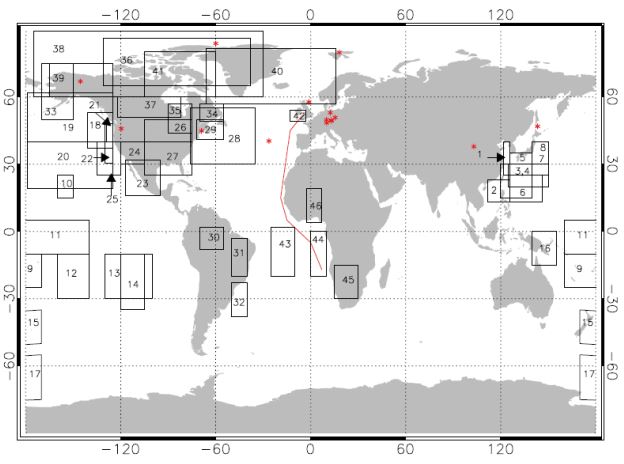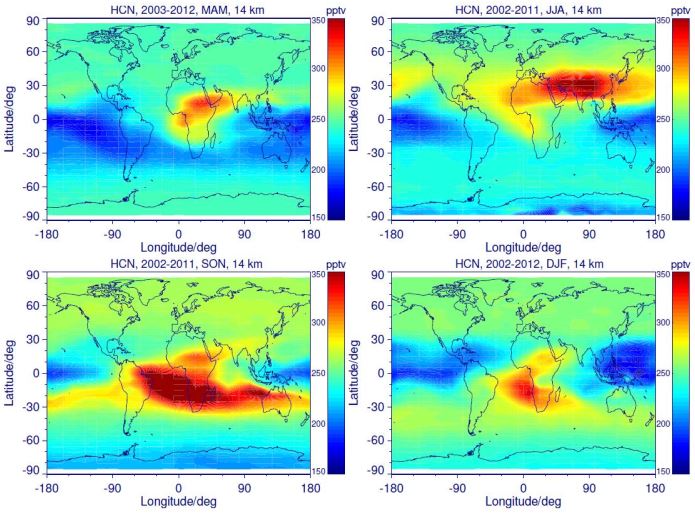← back to Scientific Themes
Biomass burning and transport of biogenic emissions in the southern Atlantic upper
troposphere
The central to southern Atlantic composition of the free and upper troposphere is influenced by emissions originating in Africa, in S-America as well as from the oceans. Long-range transport of longer-lived species is a prevalent feature especially when influenced by biomass burning in the southern hemisphere. While the southern Pacific free atmosphere has been the subject of major aircraft observational surveys, the mid-upper troposphere and lower stratosphere in the region of the central-south Atlantic has been sampled only sparsely (Fig. CHEM2-1). Up to now, satellite observation are the major source of information about the composition of the UTLS over the southern Atlantic (e.g. Glatthor et al. 2015a, 2015b, Fig. CHEM2-2). However, those observations are restricted due to their inherent limitations with respect to horizontal and, especially, vertical resolution and coverage.


Regarding biomass burning, satellite observations have suggested that the chemical composition of the pollution belt associated with S-American fires, where rainforest burning is predominant, appears different from the part of the plume associated with southern African savanna burning. Whether differences in ozone measurement are primarily driven by variable trace gas loading in the plume through different types of combustion, or whether they are driven by different prevailing uplifting processes remained an open question. An important aspect with regard to ozone is its control by the available concentrations of NOx. NOy long range transport at cold temperatures is enabled by PAN, the decomposition of which releases NOx in the remote troposphere. Studies have indicated that PAN observations in the S-Atlantic mid-troposphere are originating from biomass combustion while the amounts of NOx observed in the upper troposphere could be explained only with additional sources due to lightning (Singh et al., 1996, Smyth et al., 1996). NOx produced by lightning has been proposed as necessary to explain PAN production in the free troposphere in addition to its production in fires (Fischer et al., 2014). Further, biomass burning is the major natural source of ammonia (NH3) and, as a secondary aerosol, ammonium nitrate (NH4NO3) (Paulot et al., 2017). Those species have the capability to affect new particle formation and cirrus in the upper troposphere, which, however, has not been investigated within the BB plume over the Atlantic.
As the predominant long-lived sulfur-containing species in the troposphere carbonyl sulfide (OCS) serves as main contributor to the stratospheric aerosol-layer. Another important aspect about OCS is related to the global carbon cycle and better understanding of its sources and sinks may contribute to assess gross primary productivity in the biosphere. By use of ship-based observations in the S-Atlantic, Notholt et al., 2003 have suggested biomass burning as a possible major source of OCS. This observation, however, has not been corroborated by independent observations so far. Recently, Glatthor et al., 2015b have shown the first observations of a depletion of upper tropospheric OCS in a broad area reaching from S-America to Africa. This has been attributed to sampling of air depleted of OCS by vegetation uptake.
References
Fischer, E. V., D. J. Jacob, R. M. Yantosca, M. P. Sulprizio, D. B. Millet, J. Mao, F. Paulot, H. B. Singh, A. Roiger, L. Ries, R.W. Talbot, K. Dzepina, and S. Pandey Deolal (2014). “Atmospheric peroxyacetyl nitrate (PAN): a global budget and source attribution”. In: Atmos. Chem. Phys. 14.5, pp. 2679–2698. DOI: 10.5194/acp-14-2679-2014.
Glatthor, N., M. Höpfner, G. P. Stiller, T. von Clarmann, B. Funke, S. Lossow, E. Eckert, U. Grabowski, S. Kellmann, A. Linden, K. A. Walker, and A. Wiegele (2015a). “Seasonal and interannual variations in HCN amounts in the upper troposphere and lower stratosphere observed by MIPAS”. In: Atmos. Chem. Phys. 15.2, pp. 563–582. DOI: 10.5194/acp-15-563-2015.
Glatthor, N., M. Höpfner, I. T. Baker, J. Berry, J. E. Campbell, S. R. Kawa, G. Krysztofiak, A. Leyser, B.-M. Sinnhuber, G. P. Stiller, J. Stinecipher, and T. von Clarmann (2015b). “Tropical sources and sinks of carbonyl sulfide observed from space”. In: Geophys. Res. Lett. 42.22, pp. 10, 082–10, 090. DOI: 10.1002/2015gl066293.
Notholt, J., Z. Kuang, C. P. Rinsland, G. C. Toon, M. Rex, N. Jones, T. Albrecht, H. Deckelmann, J. Krieg, C. Weinzierl, H. Bingemer, R. Weller, and O. Schrems (2003). “Enhanced Upper Tropical Tropospheric COS: Impact on the Stratospheric Aerosol Layer”. In: Science 300.5617, pp. 307–310. DOI: 10.1126/science.1080320.
Paulot, F., D. Paynter, P. Ginoux, V. Naik, S. Whitburn, M. Van Damme, L. Clarisse, P.-F. Coheur, and L. W. Horowitz (2017). “Gas-aerosol partitioning of ammonia in biomass burning plumes: Implications for the interpretation of spaceborne observations of ammonia and the radiative forcing of ammonium nitrate”. In: Geophys. Res. Lett. 44.15, pp. 8084–8093. DOI: 10.1002/2017gl074215.
Singh, H. B., D. Herlth, R. Kolyer, R. Chatfield, W. Viezee, L. J. Salas, Y. Chen, J. D. Bradshaw, S. T. Sandholm, R. Talbot, G. L. Gregory, B. Anderson, G. W. Sachse, E. Browell, A. S. Bachmeier, D. R. Blake, B. Heikes, D. Jacob, et al. (1996). “Impact of biomass burning emissions on the composition of the South Atlantic troposphere: Reactive nitrogen and ozone”. In: J. Geophys. Res. Atmos. 101.D19, pp. 24203–24219. DOI: 10.1029/96jd01018.
Smyth, S. B., S. T. Sandholm, J. D. Bradshaw, R. W. Talbot, D. R. Blake, N. J. Blake, F. S. Rowland, H. B. Singh, G. L. Gregory, B. E. Anderson, G. W. Sachse, J. E. Collins, and A. S. Bachmeier (1996). “Factors influencing the upper free tropospheric distribution of reactive nitrogen over the South Atlantic during the TRACE A experiment”. In: J. Geophys. Res. Atmos. 101.D19, pp. 24165–24186. DOI: 10.1029/96jd00224.
